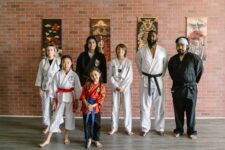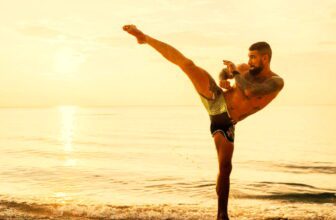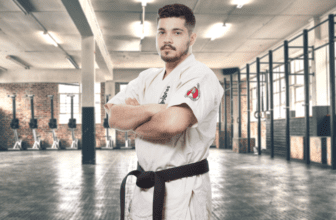Potential beginners in What does karate teach you?
Karate, an unarmed martial arts discipline, teaches individuals a wide range of valuable skills and lessons. Through its various techniques and principles, karate instills not only physical strength and self-defense abilities but also important mental and emotional attributes. Here are some key things that karate teaches:
- Discipline: Karate requires individuals to have a high level of discipline, both in training and in everyday life. The strict adherence to form, technique, and protocols cultivates discipline and self-control.
- Focus: One of the core aspects of karate is concentration. Practitioners must learn to focus their mind and body, enabling them to execute precise movements and techniques.
- Respect: Karate emphasizes respect for oneself and others. Practitioners learn to respect their teachers, their training partners, and the art itself. This respect extends beyond the training environment and can positively influence interactions in daily life.
- Determination: Karate pushes individuals to persevere and overcome challenges. Through consistent practice and the pursuit of improvement, practitioners develop a strong sense of determination and resilience.
- Confidence: As individuals progress in their karate journey, they build confidence in their abilities and themselves. The mastery of techniques and the understanding of self-defense techniques provide a sense of assurance and self-assurance.
- Self-defense skills: Karate equips individuals with practical self-defense techniques that can be used in real-life situations. By learning striking and defensive blocking with various body parts, practitioners gain the ability to protect themselves and others if necessary.
- Physical fitness: The physical demands of karate training contribute to improved overall fitness. The combination of cardiovascular workouts, strength training, and flexibility exercises enhances stamina, coordination, and agility.
- Mental resilience: Karate challenges individuals mentally by pushing them to their limits and teaching them to overcome obstacles. This mental resilience can extend beyond the training environment and help individuals face challenges in other areas of life.
- Focus on tradition and ritual: Karate has a rich history and tradition, which is reflected in its rituals and ceremonies. Practitioners learn to appreciate and respect these aspects, adding depth and cultural understanding to their practice.
- Humility: Despite the physical and mental prowess gained through karate, practitioners develop humility. They learn to recognize their limitations, acknowledge the skills of others, and approach their training with a humble mindset.Karate teaches a combination of physical techniques, mental attributes, and moral values. It is not just about learning to strike or defend oneself; it is a comprehensive discipline that promotes personal growth, self-improvement, and respect for others.
Martial Techniques: Kicking, Striking, and Blocking
Karate, the unarmed martial arts discipline, is renowned for its dynamic and powerful techniques. This ancient art form primarily focuses on three fundamental techniques: kicking, striking, and defensive blocking. These techniques are designed to utilize the entire body to generate maximum force and efficiency in combat situations.
In karate, kicks are executed with speed and precision, targeting specific vulnerable areas of the opponent’s body. The goal is to strike with accuracy and power, incapacitating the adversary effectively. Kicking techniques in karate include front kicks, side kicks, roundhouse kicks, and spinning kicks, each executed with specific intentions and varying levels of complexity.
Striking techniques in karate involve the use of various parts of the body, such as fists, palms, elbows, and knees. The practitioner learns how to generate power from the core and channel it through the striking surface, delivering devastating blows to their target. These strikes aim to disorient or immobilize the opponent swiftly and efficiently.
Defensive blocking is another essential aspect of karate. Practitioners are taught to use their arms and legs to intercept and neutralize incoming attacks. By executing precise and well-timed blocks, karate practitioners are able to protect their vital areas from harm, while simultaneously creating opportunities for counterattacks.
Concentrated Power: Impact and Precision in Karate
One of the core principles of karate is the concept of concentrated power. The goal in karate is to concentrate power at the point of impact, maximizing the effectiveness of every strike. This requires the practitioner to focus both physically and mentally, channeling their energy and directing it towards the intended target.
In order to achieve such concentrated power, karate practitioners undergo rigorous training. They learn the importance of proper body mechanics, correct alignment, and optimal use of momentum. Through countless repetitions of techniques, practitioners develop the ability to generate tremendous power from seemingly minimal movements.
Additionally, mental focus and concentration are essential components in achieving impact and precision in karate. The practitioner must learn to harness their mind, eliminating distractions and external influences. By honing their mental acuity, karate practitioners are able to execute techniques with heightened precision and accuracy, delivering strikes with the utmost efficiency and effectiveness.
Striking Surfaces: Utilizing Hands, Feet, Forearms, Knees, and Elbows
Karate encompasses a wide range of striking surfaces, each tailored to specific techniques and targets. The practitioner learns to utilize their hands, feet, forearms, knees, and elbows effectively during combat situations.
Hand strikes in karate include punches, palm strikes, and knife-hand strikes. These techniques aim to exploit the vulnerable areas of an opponent, such as the chin, solar plexus, or temple. Karate practitioners develop strong hands, capable of delivering powerful and precise strikes that can incapacitate an adversary swiftly.
Feet, being the longest limbs of the body, offer excellent reach and impact. Kicking techniques in karate include front kicks, side kicks, roundhouse kicks, and spinning kicks, each executed with specific targets and intentions. Karate practitioners develop exceptional flexibility, strength, and balance in their legs, allowing for devastating and dynamic kicks.
Forearms, knees, and elbows are also utilized as effective striking surfaces in karate. These techniques are employed in close-quarters combat, targeting the opponent’s vulnerable areas such as the ribs, sternum, or temple. The forearm strikes are typically executed with a slashing motion, delivering significant force, while knee and elbow strikes can unleash devastating power due to their close proximity to the body’s core.
Karate Matches: Stopping Blows and Kicks with Precision
Karate matches, known as kumite, involve intense and controlled combat between two practitioners. Unlike other martial arts competitions, karate matches focus on delivering strikes within an inch of contact. The emphasis is not on causing injury but on stopping the blow or kick at the precise moment before it lands.
During a karate match, the participants must exhibit exceptional agility, timing, and control. Each strike must be executed with precision, demonstrating the practitioner’s ability to judge distance and timing accurately. The goal is to showcase skill and discipline, rather than overpowering the opponent. This provides a unique and respectful approach to competitions, highlighting the technical aspect of karate.
The duration of karate matches typically lasts around three minutes. Within this time frame, participants must demonstrate their mastery of martial techniques, displaying agility, speed, and accuracy in executing strikes and blocks. Judges closely observe the competitors, scoring points based on the quality, effectiveness, and control of their techniques.
A decision in a karate match is reached if neither contestant scores a clean “killing” point. The objective is to maintain mutual respect and safety while still allowing the demonstration of skill and expertise. However, if a clean point is scored during the match, the contest will end immediately, as it signifies a definitive victory for the practitioner who scored it.
Duration and Outcome: How Long Karate Matches Last and Decision-Making Process
Beyond Physical Techniques: Mental Attitude, Courtesy, and Ranking System in Karate
While karate is renowned for its physical techniques, it is equally revered for its emphasis on developing a strong mental attitude and cultivating a spirit of respect and courtesy.
Mental attitude plays a vital role in karate training. Practitioners are encouraged to develop discipline, focus, perseverance, and resilience. Through the rigorous training and challenges faced in karate, individuals learn to overcome obstacles, both physical and mental. The mental fortitude gained through karate training can be applied to all areas of life, instilling traits of determination and resilience.
Courtesy and respect are deeply ingrained in the practice of karate. Practitioners are taught to bow in respect to their instructors and fellow practitioners as a sign of humility and acknowledgment of their expertise. Additionally, karate fosters an atmosphere of mutual respect and support, where practitioners encourage and help each other grow.
Karate also incorporates a ranking system that reflects a practitioner’s progression and skill level. This ranking system is indicated by colored belts, starting from white for beginners and progressing to black for advanced practitioners. The ranking system serves as a tangible representation of an individual’s dedication, commitment, and growth within the art form. It provides a sense of achievement and motivates practitioners to continue honing their skills.
In conclusion, karate teaches more than just physical techniques. It instills valuable qualities such as discipline, mental fortitude, respect, and courtesy. Through the practice of karate, individuals not only develop self-defense skills but also cultivate a strong character and a deeper understanding of themselves and others.
1. Discipline and Focus: Karate teaches the importance of discipline and focus in all aspects of life. Through repetitive training and practicing various techniques, students learn to maintain focus and discipline their mind and body.
2. Self-defense: One of the primary benefits of learning karate is gaining the ability to defend oneself. Karate teaches effective self-defense techniques, empowering individuals to protect themselves and others if needed.
3. Patience and Perseverance: Karate requires time and effort to master. Practicing and perfecting techniques can be challenging, but it teaches students the value of patience and perseverance. This mindset can be applied to other areas of life, helping individuals overcome obstacles and achieve their goals.
4. Respect and Humility: Karate instills deep-rooted values of respect and humility. Students are encouraged to treat their instructors and fellow practitioners with respect, fostering a positive and harmonious training environment.
5. Improved Physical and Mental Fitness: Karate is a physically demanding martial art that enhances both physical strength and mental agility. By engaging in regular karate training, students can improve their cardiovascular health, endurance, flexibility, and overall body coordination. Additionally, focusing on techniques and practicing self-control helps develop mental fitness, increasing concentration and reducing stress.







